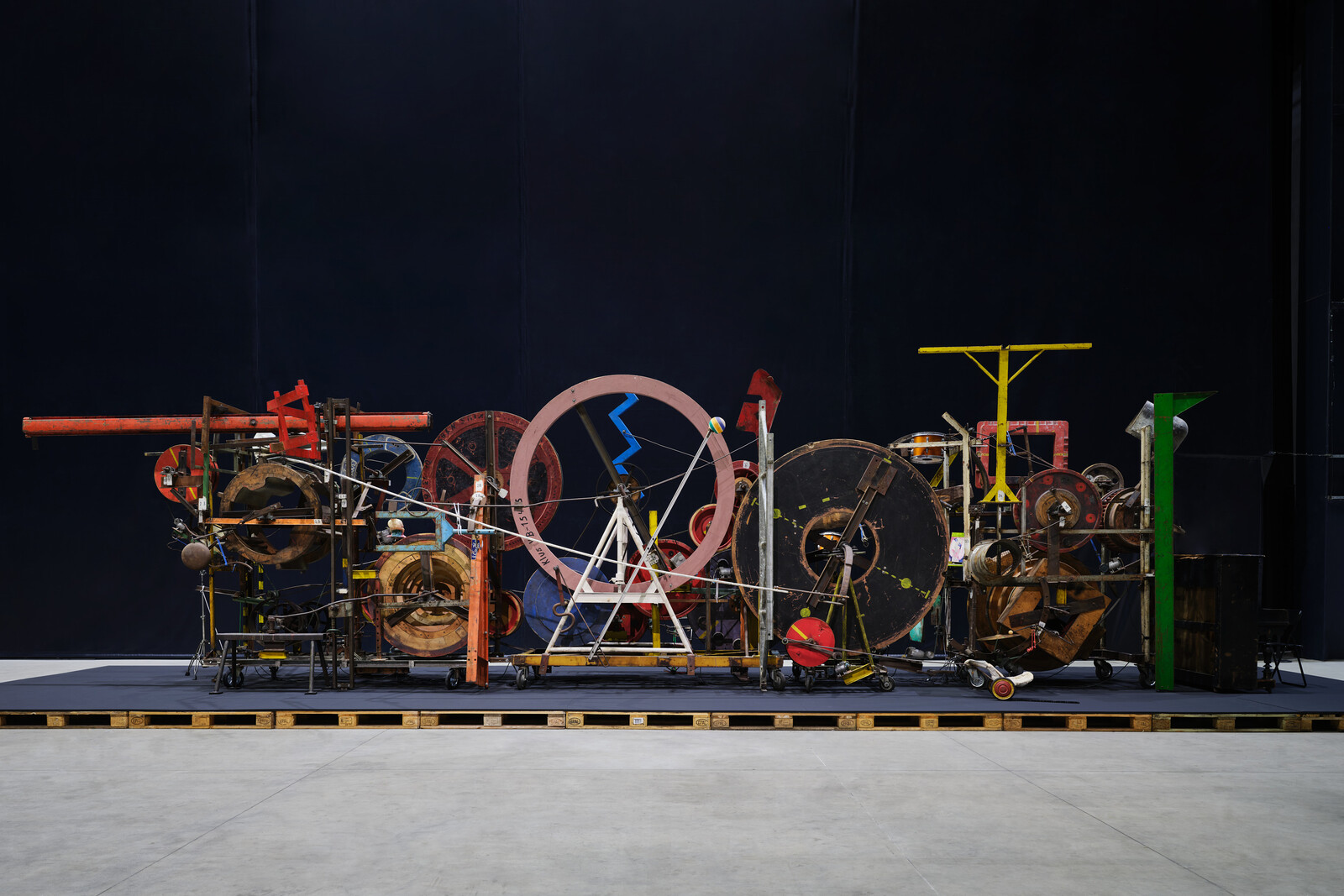October 10, 2024–February 2, 2025
Via Chiese, 2
20126 Milan
Italy
Hours: Thursday–Sunday 10:30am–8:30pm
T +39 02 6611 1573
info@hangarbicocca.org
Pirelli HangarBicocca presents the exhibition Jean Tinguely curated by Camille Morineau, Lucia Pesapane and Vicente Todolí with Fiammetta Griccioli, in collaboration with Museum Tinguely, Basel. The retrospective highlights the radical and experimental nature of Jean Tinguely, one of the artists who shaped the history of 20th century art, while emphasizing his lasting influence and continued relevance in today’s contemporary art landscape.
Jean Tinguely (Fribourg, 1925–Bern, 1991), one of the most important exponents of kinetic art, has revolutionized the concept of the artwork itself. At the heart of his work is the exploration of the machine, its function and movement, its noises and sounds, and its inherent poetry. Tinguely was one of the first artists to use found objects, gears, and other materials, which he then welded together to create noisy, cacophonous working machines equipped with real motors. His sculptures also have a performative quality due to their constant movement and the peculiar way in which they engage the audience. Gears, especially the wheel, are often the key element in the works of Tinguely, who deliberately disrupts their conventional function, liberating the machine from the “tyranny of utility” and encouraging the unexpected and ephemeral in his absurd, surprising contraptions.
Pirelli HangarBicocca’s exhibition is the most comprehensive retrospective held in Italy since the artist’s passing away and features more than forty works from the 1950s to the 1990s in the Navate space. Comprising many of his most important pieces, from his pioneering experimental kinetic sculptures to his monumental machines, the exhibition invites visitors into a unique and enthralling sound and visual environment. It includes landmark works such as the experimental Méta-mecanique sculptures of the mid-1950s, Ballet des pauvres (1961) made with household objects, and monumental machines such as Requiem pour une feuille morte (1967); Plateau agriculturel (1978) made with parts of agricultural machinery; the Philosophers series (1988–89), dedicated to ancient and modern philosophers (who theorized anti-materialism); musical machines like Méta-Maxi; and works as Pit-Stop (1984) and Shuttlecock (1990) which reveal the artist’s passion for Formula 1 and speed racing. It is also an opportunity to celebrate Jean Tinguely’s close relationship with Milan, where he created some of his most ambitious projects, epitomized by La Vittoria, an iconic performance organized in front of the Duomo on the night of November 28, 1970.
This retrospective coincides with the centenary of the artist’s birth in 2025 and is part of the palimpsest of exhibitions and cultural events dedicated to the Swiss artist and here collected: Tinguely100 (tinguely.ch/en/tinguely100.html).
Published on the occasion of the retrospective, the monograph takes an in-depth look at Tinguely’s practice by highlighting the works on display in the exhibition, through detailed work entries commissioned to art historians, curators, and scholars, accompanied by a wide selection of archival images. The volume includes an essay by art historian Béatrice Joyeux-Prunel, who contextualises Tinguely’s work within the European and American avant-garde movement, a text by scholar Melissa Warak on the role of sound and performance in Tinguely’s practice in the context of the 1960s, an interview with Renzo Piano by curator Lucia Pesapane, and an illustrated chronology of the artist by author Annalisa Rimmaudo. The publication is also enriched by the republishing of two historical texts written by Jean Tinguely and contributions by the exhibition curators, including an introduction by Vicente Todolí, a text by the curators on the exhibition project, and an essay by Lucia Pesapane recalling the artist’s strong relationship with the city of Milan, the site of some of his most ambitious projects such as La Vittoria (1970).
Pirelli HangarBicocca is a non-profit foundation dedicated to producing and promoting contemporary art. It was conceived and is supported by Pirelli. Established in 2004, Pirelli HangarBicocca has become a benchmark institution for the international art community, local public and region. It is a museum that is free of charge, accessible and open, and a place for experimentation, research and dissemination, where art is a point of reflection on the most topical themes of contemporary culture and society. It caters to a broad and diverse public with a programme of major solo exhibitions by both Italian and international artists, a multi-disciplinary program of accompanying events and in-depth discussions, theoretical and informational publications, and educational courses. A team of museum facilitators is on hand at all times to help the public connect with the art. Vicente Todolí has been the foundation’s artistic director since 2012. Situated in a former industrial building, once a locomotive manufacturing facility, Pirelli HangarBicocca occupies 15,000 square metres, making it one of the largest single-level exhibition spaces in Europe. This vast area comprises the Shed and Navate spaces, which are used for temporary exhibitions, and the permanent display of Anselm Kiefer’s The Seven Heavenly Palaces 2004-2015. This monumental installation with seven reinforced concrete towers has become one of the most iconic works in Milan.




